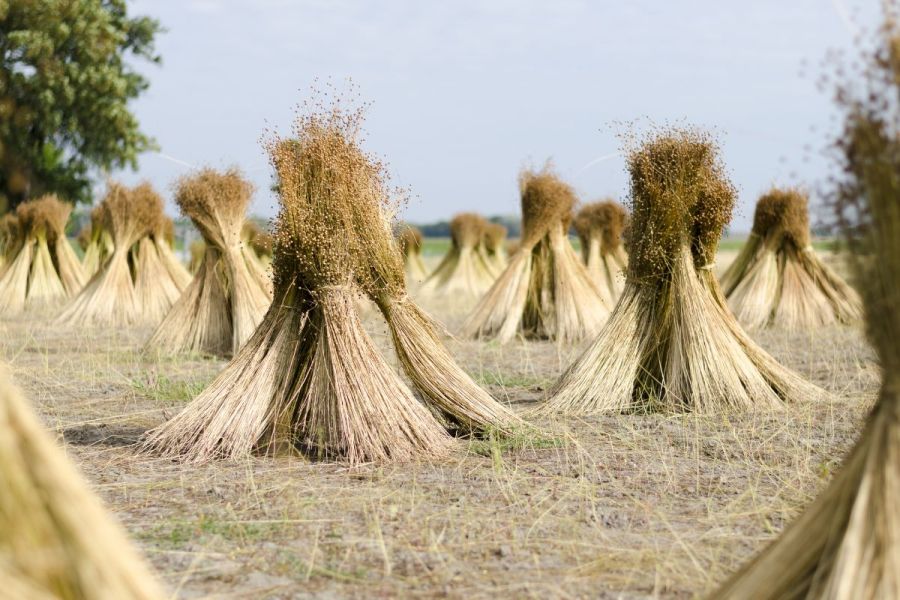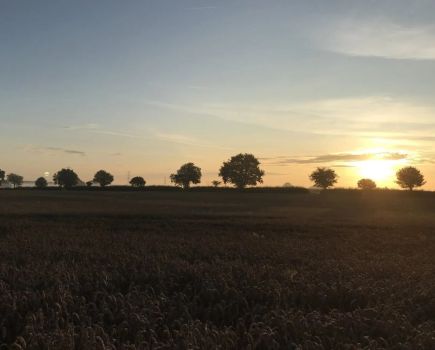As consumers begin to wise up to the pitfalls of fast fashion, could growing sustainable fibres offer UK farmers an opportunity to be part of the solution? CPM investigates.
“Farming and fashion have become disconnected, not dissimilar to farming and food.”
By Janine Adamson
In 2021, UK households spent £57bn on fashion, with the average consumer buying 60% more clothing than they did just 15 years ago. Not only does much of this end up in household black bins, around 300,000 tonnes each year, but textile production contributes more to climate change than international aviation and shipping combined.
Simply put, it’s costing ‘us’ and it’s costing the environment. But what’s the lure and can consumers break away from ‘fast fashion’ – a model based on producing clothing at large volumes and at speed for an affordable end retail cost? These garments aim to appeal to the latest trends and are cheaply made in poor working conditions, without longevity in mind.
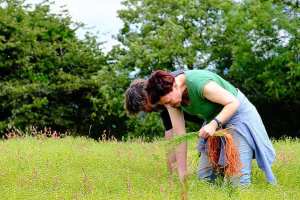
Helen Keys and Charlie Mallon are the first commercial producers of Irish linen for 40 years, growing flax on their County Tyrone farm.
Most of these textiles have made a long journey across the globe before being purchased by UK consumers. As a result, many shoppers depend on this globalised system which is designed to minimise costs at each stage of the supply chain.
But it hasn’t always been this way. The UK once boasted a thriving textile industry – in the 18th century, textiles were the second largest economic contributor after grain. However, come 2023, there are no fibre processing facilities and limited amenities for wool.
Despite this obvious gap, with sustainable farming continuing to dominate headlines, regen growers are investigating the potential for producing sustainable fibres. Flax and hemp are just two of the crops being explored.
Concurrently, the term regenerative is also arising within the fashion industry itself. According to the Guardian newspaper, for a garment to be truly regenerative, the raw materials should be farmed without synthetic fertilisers or pesticides, using techniques that restore the health of the soil, improve ecosystem functionality, water cycles and biodiversity.
As fashion designers confidently state this is the future of their trade, could now be the time for farming to step up? Northern Irish farmers Helen Keys and Charlie Mallon are doing just this as the first commercial producers of Irish linen for 40 years.
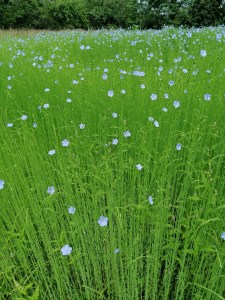
Compared with linseed, flax is taller and grown for fibre content with a reduced seed yield.
Speaking during a sustainable fibres webinar for the Nature Friendly Farming Network (NFFN), Helen says the farm returned to flax because they believed it was something they could easily manage alongside other employment, while also being profitable.
“We were looking for Irish linen and couldn’t find any actually grown in Ireland. We naively thought, we have a field which historically grew flax, which is what linen’s made from, shall we give it a go?
“We made so many mistakes along the way but that’s what innovation is about. The first year we did almost everything wrong – for one, planting a seed variety rather than fibre, it was a disaster but we learnt a lot. People kindly helped to guide us and each year we improved. Now we’re pretty good at growing it.”
Helen explains that the 20ha farm, in County Tyrone, has long had a nature-friendly approach. “We think about the environment and nature in all of our farm decisions. Examples include choosing which crops to grow, where we’re planting them, tillage choices, the role of hedgerows as nature corridors, and being conscious of avoiding watercourse pollution,” she says.
Her advice for growing flax is to try a small amount at a time. “I wouldn’t risk too much in one go. Because we didn’t have a lot of knowledge, we sought plenty of advice and asked a lot of questions, which I’d recommend doing.
“For flax to be a success, I believe it should be replicable rather than scalable. Years ago, every farm would produce a small amount and there’s certainly an opportunity to go back to that approach.”
So, what are the agronomic facts about flax? As varieties of the same plant species, Linum usitatisimum, flax can be confused with linseed. The majority of UK farmers grow commercial linseed – a short variety with less fibre that’s grown for its seed.
Flax, on the other hand, is taller and grown for fibre content with a reduced seed yield. Currently there are no processing facilities in the UK and harvest machinery is limited to specialist imports.
Simon Cooper of Cotswolds business Flaxland first became interested in the crop in 2008, while working on a 600ha farm that grew linseed. At the same time he was handling flax-based covers for boats and canoes and quickly recognised the potential of the material.
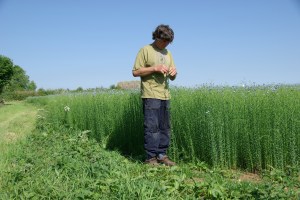
According to Simon Cooper, flax poses an opportunity for both smaller-scale artisan growers, and commercial farmers.
“I put two and two together and realised flax is a strong, natural fibre that we could grow on the farm alongside our other crops of wheat, barley, oilseed rape and, of course, linseed. We approached it from a biocomposite angle – creating a blended natural material for outdoor use,” he says.
Simon’s now racked up around 15 years’ experience, growing the crop for a wide range of uses, including involvement with a community project supported by BBC Sewing Bee’s Patrick Grant. The Homespun/Homegrown project utilised disused urban land to grow flax for linen and woad for indigo, working with the local Blackburn community to make a pair of jeans.
During the years, Simon’s learnt a lot about flax management. “Flax grows in most soils, developing rapidly with around 100 days between planting and harvesting. It’s sown from late March into early May, when the soil has warmed.
“You sow at a high seed rate, aiming to establish 2000 plus plants/m2, which equates to approximately 12g of seed,” he explains.
Simon stresses that seed should be certified for vigour and purity, as well as a specified variety for fibre production. He says that once up and away, the crop grows rapidly and is unlikely to require watering, but when grown on a small-scale, should be hand weeded until plants are competitive.
Compared with linseed, the two crops behave very similarly. “For most varieties, flax flowers are blue and self-pollinating. The buds open in the morning and drop by evening, with more flowers following the next day. Once this has finished, the seed bolls swell, leaves turn yellow and stems gradually become firmer.”
He explains that most flax is harvested between four and six weeks after flowering, with plants pulled by hand and laid flat for retting (rotting). It’s this hands-on requirement that he says makes the crop difficult to scale-up.
“In the UK, we lack the infrastructure to process flax, it’s all by hand. As a result we have to collaborate with people in the EU which is a real stumbling block in moving its potential forward,” says Simon.
“We’re currently operating in two realms – smaller-scale, artisan growers who appeal to niche markets, plus the commercial farming world who wish to make the crop viable. I believe there’s a place for both in the textile industry, I don’t think there’s a risk of one overtaking the other.”
According to Simon, work’s now taking place to understand whether existing linseed varieties can be grown for seed and fibre as a dual-purpose crop. Initial research has confirmed that the fibre yield of linseed does have potential for both applications, which could mean a leap forward for scaling-up sustainable fibre production.
In the meantime, Suffolk-based Hans de Putter is using his European connections to drive UK flax towards commercial success. Having first experienced the crop while growing up on the Dutch-Belgian border, he was well aware of it’s potential as a sustainable fibre.
Now, together with Belgian grower Robrecht Engels, the pair support UK farms to produce flax for export into Europe. “In year one we worked with three businesses and a total 65ha of flax, but this has since grown to six farms with around 160ha,” says Hans.
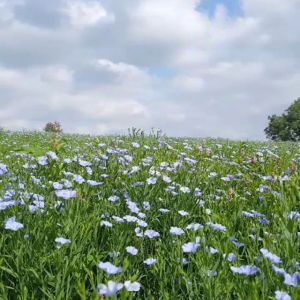
Flax seed should be certified for vigour and purity, as well as a specified variety for fibre production.
“We believe this growth is due to the increasing demand for flax, both domestically and internationally. In fact, we soon expect to be supporting 10 farms across Suffolk and Essex, amounting to around 250ha.”
To accommodate this rise in demand, the business, Flax Cultivation, has invested in specialist machinery to help upscale production and reduce the man hours traditionally associated with the crop. Hans also owns a second enterprise – Danmar Logistics, which he says has provided necessary transport assistance between the UK and Europe.
However, despite being grown in the UK, this is where it currently ends. “Our flax bales are processed in Belgium, but we believe in a few years we’ll have enough product to justify a UK scutching [extraction of fibre from retted flax straw] factory, operating all year round,” says Hans. “This would provide local employment and increase the value of the product.”
According to Hans, a lack of spinning facilities in Western Europe means through his current model, flax has to be exported again to the Far East, which will undoubtedly be disappointing from a sustainability perspective.
He stands firm that flax offers a range of benefits beyond simply being a break crop. “There’s no waste, everything from the plant is used. Growing flax also improves soil structure in readiness for following rotational crops such as wheat or barley.”
Irrespective of enthusiasm, one challenge remains evident – the lack of UK infrastructure. Kit Christina Keawwantha of Fibershed Ireland spoke during the NFFN webinar, explaining that the answer could lie in a community-centric solution. “Processing infrastructure should be re-built and updated, with a focus on community-owned, regional fibre mills that ideally run on renewable energy.”
She believes agricultural systems should change approach from extraction to reciprocity, de-commodifying people and the planet by switching from resource to relationship. “This can be achieved by ensuring enterprises are viable and value the non-financial returns the industry could provide, such as ecosystem services and community relationships,” says Kit Christina.
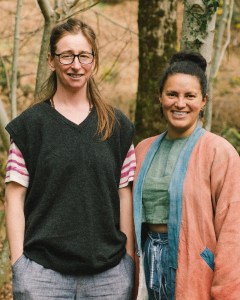
Kit Christina Keawwantha and Malú Colorín believe the UK would benefit from a community- centric approach to sustainable fibre production.
“Ask the question – why are we working towards this? Is it purely for quantitative financial gains, or could we achieve wider, qualitative benefits as well?”
Fibershed is a global not-for-profit movement striving to create an alternative framework for the current fossil fuel-dependent textile industry. Work centres around developing regional fibre systems, expanding opportunities to implement regen farming approaches while rebuilding localised manufacturing facilities.
Malú Colorín says the movement’s ethos is grounded in the concept of soil-to-soil systems, where textiles are produced from natural materials and at the end of their life can be returned to the soil safely. “This is the ultimate circular system with no waste, with textiles going back to the soil to generate new life.
“Farming and fashion have become disconnected, not dissimilar to farming and food. But this doesn’t mean we should return to how things once were. We have to assess learnings and then build on them to forge a different path forward based on the soil and local networks,” she says.
Encouragingly, Fibreshed’s vision could become reality sooner rather than later. Funding has recently been secured for the Fibre to Fabric project which aims to restore Northern Ireland’s textile heritage.
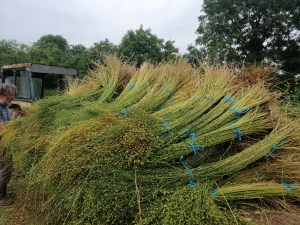
Most flax is harvested between four and six weeks after flowering, pulled by hand and laid flat for retting (rotting).
The project was launched as a result of Mourne Textiles’ Mario Sierra finding a complete set of industrial flax spinning machines in a derelict linen mill. Although old, he says the machines are still relevant for today and plans to work with Helen of Mallon Linen to bring them back to life.
“We want to promote sustainable fabric production here on the Island of Ireland, by creating a field-to-fabric circular supply chain. Restoring the processing and spinning equipment is the missing link required to convert flax fibres into yarn,” says Mario.
But how about the fashion brands and their stance on UK-grown sustainable fibres? It appears to be a niche marketplace at the moment, catered for by city-centric labels such as Flax London and smaller artisan designers. CPM reached out to some of farming’s favourites who all have sustainability policies, but at the date of publish, was yet to receive a response.
This article was taken from the latest issue of CPM. For more articles like this, subscribe here.
Sign up for Crop Production Magazine’s FREE e-newsletter here.

